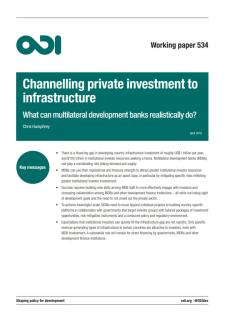
The international development agenda has in recent years increasingly zeroed in on the importance of ramping up investment in basic infrastructure in emerging and developing countries (EMDCs). Investment is falling well short of the level required to keep pace with economic growth, generate opportunities for a fast-growing global population and shift our planet onto a sustainable path.
In the face of a financing gap in EMDCs of the order of $1 trillion per year between now and 2030, the public sector is not capable of undertaking the needed investments on its own. Private investors – notably the roughly $100 trillion in institutional investor resources – would be able to help fill this gap, as infrastructure assets offer the kind of opportunities these investors seek. However, information gaps and risk perceptions have thus far prevented large-scale institutional investment in EMDC infrastructure. The disconnect between profitable infrastructure investment opportunities with tremendous social benefits and large volumes of available finance seeking a home suggests a useful role for official coordination.
Multilateral development banks can play that role by linking demand and supply. They can use their reputational and financial strength to attract greater institutional investor resources and facilitate developing infrastructure as an asset class, in particular by mitigating specific risks inhibiting greater institutional investor involvement. This paper focuses in particular on three techniques oriented towards infrastructure debt finance: project bonds, securitisation of infrastructure loans and syndication arrangements.
